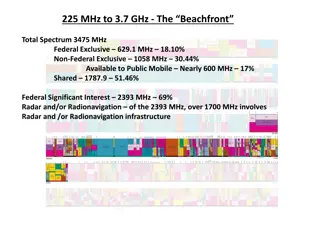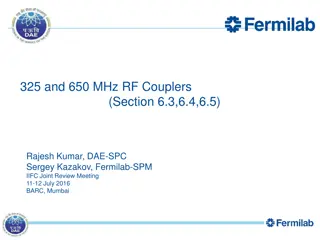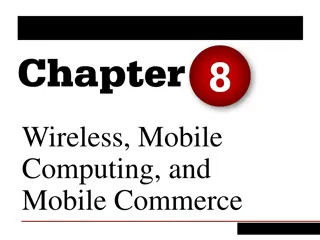Way Forward on Release Independence for 35 and 45 MHz in Mobile Networks
Discussion at the 3GPP TSG-RAN-WG4 Meeting #97-e focused on release options for 35 and 45 MHz frequencies. Different options were explored for release independence, hardware capabilities, backward compatibility issues, and commercial implementation aspects concerning various stakeholders such as T-Mobile, AT&T, Nokia, and others.
Download Presentation

Please find below an Image/Link to download the presentation.
The content on the website is provided AS IS for your information and personal use only. It may not be sold, licensed, or shared on other websites without obtaining consent from the author.If you encounter any issues during the download, it is possible that the publisher has removed the file from their server.
You are allowed to download the files provided on this website for personal or commercial use, subject to the condition that they are used lawfully. All files are the property of their respective owners.
The content on the website is provided AS IS for your information and personal use only. It may not be sold, licensed, or shared on other websites without obtaining consent from the author.
E N D
Presentation Transcript
3GPP TSG-RAN WG4 Meeting #97-e Electronic Meeting, 2-13 Nov., 2020 R4-2016862 Way Forward on Release independence for 35 and 45 MHz T-Mobile USA, TELUS, Bell Mobility, AT&T, Nokia
Background: Release options for 35 and 45 MHz Option 1: The support of 35 MHz and 45 MHz is from Rel-17 onwards Supported by ZTE OPPO and Apple Option 2: 35 MHz and 45 MHz is optional support from Rel-15 Supported by Ericsson, T-Mobile USA, Nokia, AT&T, Bell Mobility, TELUS, Skyworks Option 3: Release independence shall be discussed cases by case per band
Background: 5 Aspects UE signalling UE Hardware capability Backward Compatibility Issues Band specific work Commercial implementaiton/deployment aspects
Aspect 1: Signalling RAN2 reserved bits for new channel BWs channelBWs-DL and channelBWs-UL have 10 bits per SCS, used to indicate 5, 10, 15, 20, 25, 30, 40, 50, 60 and 80MHz channelBWs-DL-v1590 and channelBWs-DL-v1590 have 16 bits For FR1, the leading/leftmost bit in channelBWs-DL-v1590 indicates 70MHz, and all the remaining bits in channelBWs-DL-v1590 shall be set to 0. channelBWs-DL-v1590 and channelBWs-DL-v1590 therefore have 15 spare bits to be used for new FR1 channel BWs RAN2 could allocate one bit each for 35 and 45 MHz. There is no signalling issue for adding 35 and 45 MHz Release- independent for Rel-15
Aspect 2: Hardware capability Implementation of new channel BWs may require new filter hardware in the UEs that support the new channel BWs and the gNBs that support the new channel BWs Optional inclusion of 35 MHz and/or 45 MHz in new Rel-15 and 16 UEs won t impact the hardware of legacy UEs or gNBs. Since 45 MHz would be the widest channel BW for n25 and n66, it should be optional for Rel-17 New bands have hardware capability issues also, but are almost always release independent. Conclusion: Hardware capability shouldn t impact release independence
Aspect 3: Backward compatibility issues Adding the new channel BW doesn t cause any backward compatibility issues Compatibility Matrix gNB does not support new CH BW gNB supports new CH BW UE does not support new CHBW(s) Baseline functionality UE doesn t set new capability bit(s), so gNB treats the UE like any UE that doesn t support a particular channel BW UE supports new CHBW gNB ignores the capability bits for the new channel BW(s) UE can use the new channel BWs if deployed by the gNB
Aspect 4: Band specific work Some bands may have band specific work needed, like REFSENS, MSD, A-MPR, etc. Adding legacy channel BWs to existing bands also can have band specific work like MSD, A-MPR, etc. Band specific requirements can be established when the WID adds the bandwidth(s) for the particular and made backward compatible with earlier releases.
Aspect 5: Commercial implementations/deployment aspects Some vendors have expressed concerns about product plans already being in place for Rel-15 and Rel-16 If we make the new channel BWs optional for Rel-15 and Rel-16, then vendors can choose their own timeline for implementation. RAN4 can decouple commercial implementation/deployment plans from release independence. This should give both sides the flexibility they need. If operators can convince vendors to implement the channel BWs in Rel-15 or Rel-16, great, otherwise they must wait until Rel-17 (or later). This approach would let the market decide when the new channel bandwidths are implemented in products, as is with new bands.
Release independence on a case-by-case basis per band and bandwidth Release independence is primarily a protocol issue. Since the signalling can support the new channel BWs, they can be release independent to Rel-15. As we have seen, the discussion of release independence takes a lot of time and is contentious. Delegate time could be better spent on other issues instead of discussing release independence on a case by case basis per band and per bandwidth. Having the new channel BWs be release independent on a case by case basis per band bandwidth would unnecessarily complicate TS 38.307 Vendors can choose to which release to implement the new channel BWs on a case-by-case basis per band and bandwidth
Proposals Proposal 1: 35 and 45 MHz channel bandwidths shall be release independent to Release 15 Proposal 2: 35 and 45 MHz shall be optional in Release 15, Release 16 and Release 17 Proposal 3: Any additional requests to add 35 and 45 MHz channel BWs to a band shall be added via this WID in Rel-17, not the basket WID. Proposal 4: The 35 and 35 MHz WID will add a generic example band combination to be used as an example for future band combination requests. (The example may also be added to the basket WID). Proposal 5: Explore if it is possible to turn channel BW table pages to landscape mode to allow space for the inclusion of 35 and 45 MHz. Proposal 56 Send an LS to RAN2 asking them to allocate the signalling for 35 and 45 MHz from Rel-15.























